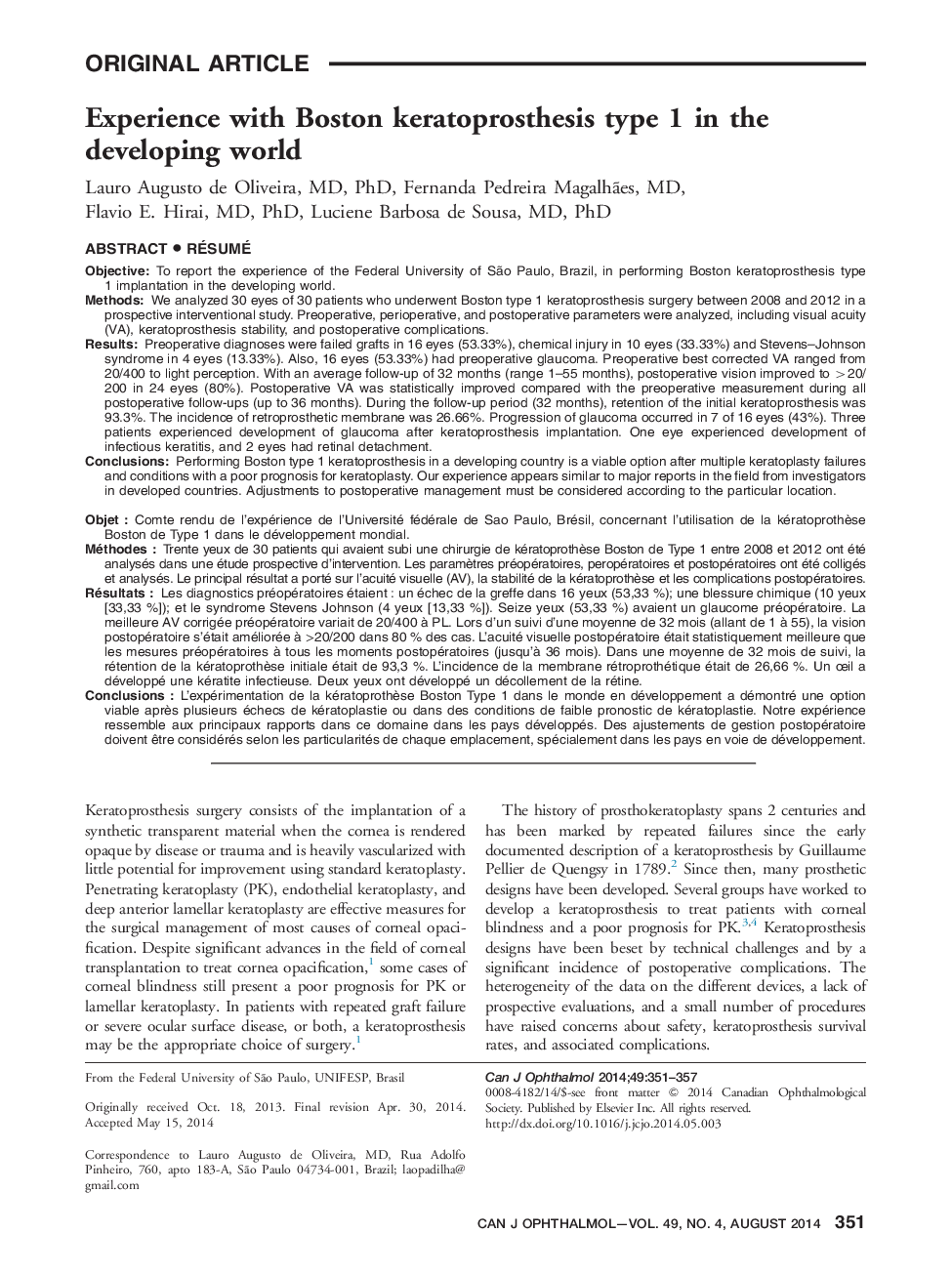| Article ID | Journal | Published Year | Pages | File Type |
|---|---|---|---|---|
| 4009320 | Canadian Journal of Ophthalmology / Journal Canadien d'Ophtalmologie | 2014 | 7 Pages |
ObjectiveTo report the experience of the Federal University of São Paulo, Brazil, in performing Boston keratoprosthesis type 1 implantation in the developing world.MethodsWe analyzed 30 eyes of 30 patients who underwent Boston type 1 keratoprosthesis surgery between 2008 and 2012 in a prospective interventional study. Preoperative, perioperative, and postoperative parameters were analyzed, including visual acuity (VA), keratoprosthesis stability, and postoperative complications.ResultsPreoperative diagnoses were failed grafts in 16 eyes (53.33%), chemical injury in 10 eyes (33.33%) and Stevens–Johnson syndrome in 4 eyes (13.33%). Also, 16 eyes (53.33%) had preoperative glaucoma. Preoperative best corrected VA ranged from 20/400 to light perception. With an average follow-up of 32 months (range 1–55 months), postoperative vision improved to >20/200 in 24 eyes (80%). Postoperative VA was statistically improved compared with the preoperative measurement during all postoperative follow-ups (up to 36 months). During the follow-up period (32 months), retention of the initial keratoprosthesis was 93.3%. The incidence of retroprosthetic membrane was 26.66%. Progression of glaucoma occurred in 7 of 16 eyes (43%). Three patients experienced development of glaucoma after keratoprosthesis implantation. One eye experienced development of infectious keratitis, and 2 eyes had retinal detachment.ConclusionsPerforming Boston type 1 keratoprosthesis in a developing country is a viable option after multiple keratoplasty failures and conditions with a poor prognosis for keratoplasty. Our experience appears similar to major reports in the field from investigators in developed countries. Adjustments to postoperative management must be considered according to the particular location.
RésuméObjetComte rendu de l’expérience de l’Université fédérale de Sao Paulo, Brésil, concernant l’utilisation de la kératoprothèse Boston de Type 1 dans le développement mondial.MéthodesTrente yeux de 30 patients qui avaient subi une chirurgie de kératoprothèse Boston de Type 1 entre 2008 et 2012 ont été analysés dans une étude prospective d’intervention. Les paramètres préopératoires, peropératoires et postopératoires ont été colligés et analysés. Le principal résultat a porté sur l’acuité visuelle (AV), la stabilité de la kératoprothèse et les complications postopératoires.RésultatsLes diagnostics préopératoires étaient : un échec de la greffe dans 16 yeux (53,33 %); une blessure chimique (10 yeux [33,33 %]); et le syndrome Stevens Johnson (4 yeux [13,33 %]). Seize yeux (53,33 %) avaient un glaucome préopératoire. La meilleure AV corrigée préopératoire variait de 20/400 à PL. Lors d’un suivi d’une moyenne de 32 mois (allant de 1 à 55), la vision postopératoire s’était améliorée à >20/200 dans 80 % des cas. L’acuité visuelle postopératoire était statistiquement meilleure que les mesures préopératoires à tous les moments postopératoires (jusqu’à 36 mois). Dans une moyenne de 32 mois de suivi, la rétention de la kératoprothèse initiale était de 93,3 %. L’incidence de la membrane rétroprothétique était de 26,66 %. Un œil a développé une kératite infectieuse. Deux yeux ont développé un décollement de la rétine.ConclusionsL’expérimentation de la kératoprothèse Boston Type 1 dans le monde en développement a démontré une option viable après plusieurs échecs de kératoplastie ou dans des conditions de faible pronostic de kératoplastie. Notre expérience ressemble aux principaux rapports dans ce domaine dans les pays développés. Des ajustements de gestion postopératoire doivent être considérés selon les particularités de chaque emplacement, spécialement dans les pays en voie de développement.
